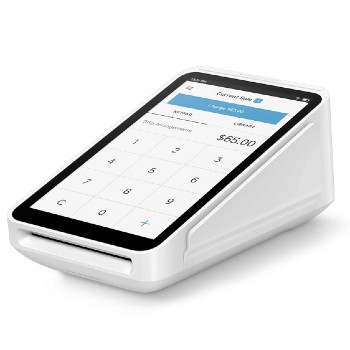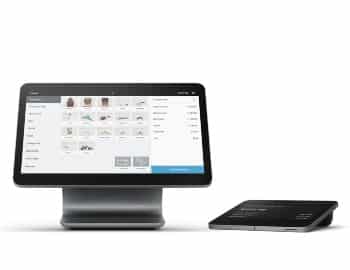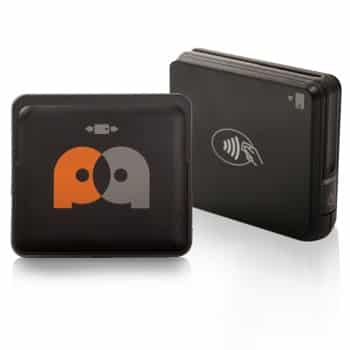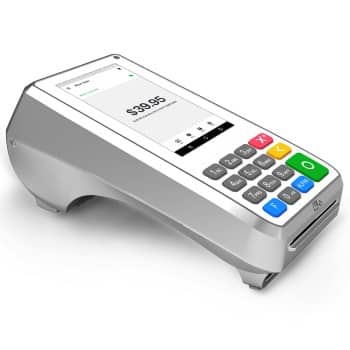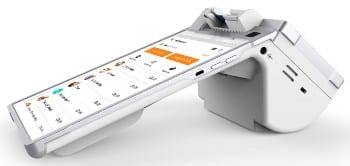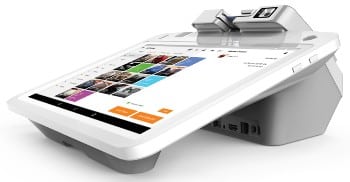When comparing Payanywhere vs Square, they may appear interchangeable because they both offer a free card reader, an app with point-of-sale (POS) tools, and the credit card processing fees are similar: Payanywhere charges 2.69% per transaction; Square, 2.6% plus 10 cents per transaction. However, Square gets better reviews, offers better software, and generally provides a better value than Payanywhere, although small sellers with average sales below $20 will pay less in transaction fees by choosing Payanywhere.
- Payanywhere: Affordable option for small sellers consistently processing under $5,000 monthly with an average transaction value lower than $20.
- Square: Best for most small businesses, individuals, seasonal or occasional sellers, and those wanting free online and in-store POS systems.
Consider an Alternative: Helcim
Helcim offers lower transaction fees and free POS software. In fact, all of Helcim’s tools are free to use. If your business is growing and you’re looking to save on processing fees, Helcim might be a better fit. Visit Helcim to learn more, or see how it compares below.
Payanywhere vs Square Quick Comparison
When to Use a Traditional Merchant Account
A brick-and-mortar store owner might want to consider opening an account with a merchant services provider instead of Square or Payanywhere to save on processing fees. Helcim, for example, offers some of the cheapest credit card processing rates for small businesses.
While using a payments app like Square or Payanywhere is easy and convenient, a traditional merchant account offered through a bank, such as Chase Payment Solutions®, offers more security and stability and faster deposit times. Merchant accounts have a longer sign-up process, often charge fees, and may only work with businesses that make a minimum amount of monthly transactions—usually over $5,000.
Why Square Is Best for Most Businesses
Square offers the best all-purpose payment and software solution for individuals, new businesses, and small businesses. In addition, it has advanced paid plans and tools for midsize businesses, from banking services to payroll, and offers custom solutions for large businesses, including reduced rates for high-volume sales. Thus, it can grow with you.
It is free and effortless to use and requires no application or commitment. See our guide to Square to learn more about its different product offerings and find out if it’s right for your business.
See why Square tops so many of our evaluations:
Best for Affordability: Square
Monthly POS Subscription | $0 to $44.95 | $0 to $299 with add-on programs |
Card Reader Pricing | Starts at $59.95 | $0 to $49 |
Terminal and Register Pricing | $349.95 to $949.95 plus setup fees and POS software subscription | $149 to $799 (all-inclusive) |
Card-present Transaction Fees | 2.69% | 2.6% plus 10 cents |
Ecommerce Transaction Fees | 3.49% plus 19 cents | 2.9% plus 30 cents |
ACH Transaction Fees | 3.49% plus 19 cents | 1% processing fee, minimum $1* |
Chargeback Fees | Not disclosed | Waived up to $250 per month |
*ACH payments available only through Square Invoices.
The processing fees are similar, but if you need more hardware than a simple card reader, Square is by far the cheaper option. Its terminals are well-regarded by users and come with the software free. Payanywhere charges a subscription fee for software on its devices and has a $3.99 per month inactivity fee (after 12 months) if you stop using the app without canceling your subscription.
When Payanywhere Might Be More Affordable
When it comes to Square vs Payanywhere fees, Payanywhere’s 2.69% processing fee seems higher than Square’s 2.6% plus a 10-cent transaction fee. For most businesses, it is. However, for sellers with average sales below $20, such as cafes selling cups of coffee, Square’s fee per transaction would be higher than Payanywhere’s additional 0.09% charge per transaction. So, for merchants with low price points, Payanywhere could be more economical.
Best for Payment Processing: Square
Best for | Low-volume sellers with average sales under $20 | Most individuals and small businesses |
High-volume Discounts | Moves you to its merchant account, which is a different contract | Discounted rates for merchants processing over $250,000 in annual credit card sales |
Payment Types | Credit card, debit card, and contactless payments | Credit card, debit card, contactless payments, gift cards, and ACH |
Invoicing | Simple, recurring, and autopay | Simple, recurring, and autopay |
Virtual Terminal | Included | Included |
Card-on-File | Included | Included |
Ecommerce | None | Included |
Payment Card Industry (PCI) compliance | Included | Included |
Our scores for Payanywhere and Square in other articles make Square a clear winner. Both Square and Payanywhere offer flat-rate and transparent pricing for new and small merchants. Once your business starts to grow, Payanywhere will switch you over to a traditional merchant account that uses a tiered pricing model. Generally, we don’t recommend tiered pricing models for small businesses because they can be unpredictable. Learn more about Payanywhere’s pricing and plan options.
Meanwhile, Square does not offer different pricing levels. However, it offers custom discount rates for businesses processing over $250,000 annually. If your business does process this much, it’s likely neither Square nor Payanywhere is your best option. See our list of the best merchant services for small businesses to find the right payment solution for you.
Alternative In-Person Payment Options
Aside from card readers, both Square and Payanywhere offer alternative ways to accept in-person payments. Quick Response (QR) codes payments are now a popular in-person payment option you can find in almost every mobile payment app. Payanywhere launched QR code payments on its platform in September 2022 while Square’s have been available since the early days of the COVID-19 pandemic. Square also now uses QR code technology for online ordering.
Additionally, Square offers Tap to Pay on iPhone and Android which allows merchants to use compatible mobile phones as card readers. While Square made this available for iPhones in September 2022 and for Android in April 2023, Payanywhere also launched this functionality for iPhones starting October 2023.
Best for POS App: Square
Best for | Small and midsize businesses (SMBs) with low-price transactions | Startups, seasonal businesses, solopreneurs, budget-minded small businesses; custom solutions for large businesses |
Industry-specific Software Options | One all-purpose POS with two themes” “terminal” and “retail” | All-purpose, retail, restaurants, and appointments, CBD retail |
POS Features | Basic register, inventory, customer management, employee management; free for phone; monthly subscription if you use hardware | Free basic register, inventory, customer management, employee management; plans include advanced features, and add-on programs add more functions |
Checkout Features | Split tender, open tabs, discounts, tips, digital receipts, and refunds | Split tender, open tabs, discounts, tips, digital receipts, refunds, chargeback protection; simplified checkout for consumers with Cash App |
Product Catalog | Items, categories, modifiers, discounts, low stock alerts, barcode scanning, phone barcode scanning, reports | Variations, photos, inventory tracking, low-stock alerts, reports, barcode scanning |
Customer Management | Customer information and purchase tracking | Customer information and purchase tracking, loyalty features, marketing |
Employee Management | Time clock, scheduling, labor forecasts, employee roles with permissions, and track sales by employee | Time clock, permissioning, can add on Square Payroll and Team Management |
Integrations | QuickBooks and Homebase; need application programming interface (API) for others | Hundreds of apps in 16 categories |
Square is the clear winner when it comes to sales features and functionality. While Payanywhere provides the basics for in-person and online transactions, Square offers many more online sales and customer management features.

Square offers some of the best POS systems for small businesses. (Source: Square)
Square is a recognized leader in sales for both in-store and online. Its free POS system is powerful enough for busy retailers and restaurants but simple enough for the hobbyist who only sells a few items at the farmers’ market. In 2019, it opened its services to cannabidiol (CBD) businesses. It offers more features than Payanywhere for customer support, and the paid plans have even greater functionality.
Square Online has another advantage for sellers–it offers BNPL payments through Square’s integration with Afterpay. On the other hand, Payanywhere does not offer any BNPL methods.
To see all of Square’s app features, read our Square POS review.
When to Use Payanywhere
One handy feature Payanywhere offers that Square does not is mobile barcode scanning. Scan the barcode with your phone, and it can pull up the product. This barcode scanner can save you money on equipment and make it easier for employees on the floor to look up items for a customer.
Otherwise, Payanywhere is good when it comes to brick-and-mortar or mobile sales—but not on the level of Square. It does not offer a loyalty program, and most extra functions like marketing will require third-party integrations. Further, its online offerings are weak, consisting of only payment links and a virtual terminal.
Best User Reviews: Square
Capterra | 3.6 out of 5 (10+) | 4.7 out of 5 (2.2K+) |
G2 | 4.7 out of 5 (3) | 4.6 out of 5 (140+) |
Trustpilot | 2.7 out of 5 (7) | 4.3 out of 5 (4.2K+) |
Apple App Store rating | 3.9 out of 5 based (730+) | 4.8 out of 5 (400.2K+) |
Google Play Store rating | 3.6 out of 5 based (4.4K+) | 4.8 out of 5 (213K+) |
Users Like |
|
|
Users Don’t Like |
|
|
When it comes to Payanywhere vs Square user reviews, Square stands out as the frontrunner. It boasts a substantial user base, reflected in its impressive ratings across multiple platforms. Users on Capterra, G2, and Trustpilot consistently commend Square for its ease of use, reasonable transaction fees, and absence of a monthly fee. These positive feedbacks make Square a popular choice for businesses looking for a straightforward and cost-effective payment solution.
In contrast, Payanywhere receives mixed reviews, with a lower overall rating on Capterra and Trustpilot. While some users appreciate its simplicity and cost-effectiveness, concerns about app crashes, limited features, and account holds have been raised. The smaller number of reviews and lower ratings suggest that Payanywhere is not as universally embraced or reliable as Square.
Best for Ease of Use: Square
User Reviews* | 3.9 out of 5 | 4.7 out of 5 |
Expert Score | Good | Excellent |
Phone and support email | Monday through Friday, 8 a.m. to 9 p.m. Eastern time; Saturday and Sunday, 8 a.m. to 6 p.m. ET | Monday through Friday, 8 a.m. to 5 p.m. Pacific time |
Online resources | Knowledge base with guides and video tutorials | Knowledge base with guides, videos, articles, and a seller community forum |
*Based on Ease of Use score in user review sites.
Setting up and using Payanywhere and Square are equally easy, but when you get to the reliability of each payment processor, you can break that tie and give the win to Square. Just comparing how intuitive each app is designed, Square pulls ahead.
Square became a household name because it brought payment processing to the small sellers without access to a merchant account—and it made it ridiculously easy to accept credit card payments. The app has easy-to-learn menus and categories, and the language used makes sense.
The user experience (UX) is an essential part of an intuitive interface, and Square gets it right with its POS app. You can create new items for your inventory, apply a discount to sales, and set up sales tax without having any prior experience.
Square gets points for designing an app that’s not only user-friendly but also stable. I’ve never had it freeze or crash and payments always go through.
On the other hand, Payanywhere is easy to set up but can be unreliable. Getting started is easy enough. If you choose the Pay As You Go plan, you’ll choose the reader you want and fill out a form with your contact information; then you can sign in and start setting up your profile and inventory. The Payanywhere app is easy to use, and it includes a Test Drive feature, which allows you to try it out before you commit.
As it applies to apps and payment processing software, intuition is such a subjective thing. But when comparing Payanywhere to Square, it doesn’t quite hit the intuitive mark. You can switch between a typical terminal view and retail view, and it isn’t immediately obvious where to go to find inventory (Payanywhere labeled this setting “Themes”).
Despite how easy Payanywhere makes it to start accepting credit cards for payment, it has some issues. The app often freezes, won’t load photos, and crashes—and you have to kill the app, then restart it to use it again. These are the sorts of glitches you don’t need when you’re trying to accept someone’s credit card, and you could quickly lose a customer’s trust.
Best Hardware: Square
Square and Payanywhere boast similar hardware offerings, with mobile card readers for the phone, a handheld mobile terminal, and a standalone terminal. Hardware prices are also somewhat similar but Payanywhere’s software for its smart terminals is an add-on cost whereas Square’s POS app is free to use.
When to Choose Payanywhere
Since our last update, Payanywhere removed its 2-in-1 mobile card reader which they offer for free for new merchants. Its 3-in-1 card reader is still available for $59.95 and is ideal for business owners who prefer a more handy, single device to carry around when accepting payments on the go. Payanywhere also offers a more ergonomic terminal that is easier to carry than the Square Terminal.
Methodology—How We Evaluated Payanywhere and Square
We test each merchant service provider ourselves to ensure an extensive review of the products. We then compare pricing methods and identify providers that offer zero monthly fees, pay-as-you-go terms, and low transaction rates. Finally, we evaluate each according to various payment processing features, scalability, and ease of use.
The result is our list of the best merchant services providers. However, we adjust the criteria for specific use cases, such as for different business types and merchant categories. This is why every provider has multiple scores across our site, depending on the use case you are looking for. For this in-depth analysis, we looked closely at how Payanywhere and Square performed.
Click through the tabs below for our overall merchant account evaluation criteria:
25% of Overall Score
We awarded points to merchant account providers that don’t require contracts and offer month-to-month or pay-as-you-go billing. Additionally, we prioritized providers that don’t charge hefty monthly fees, cancellation fees, or chargeback fees and only included providers that offer competitive and predictable flat-rate or interchange-plus pricing. We also awarded points to processors that offer volume discounts, and extra points if those discounts are transparent or automated.
30% of Overall Score
The best merchant accounts can accept various payment types, including POS and card-present transactions, mobile payments, contactless payments, ecommerce transactions, and ACH and echeck payments, and offer free virtual terminal and invoicing solutions for phone orders, recurring billing, and card-on-file payments.
25% of Overall Score
We prioritized merchant accounts with free 24/7 phone and email support. Small businesses also need fast deposits, so payment processors offering free same-day or next-day funding earned bonus points. Finally, we considered whether each system has affordable and flexible hardware options and offers any business management tools, like dispute and chargeback management, reporting, or customer management.
20% of Overall Score
We judged each system based on its overall pricing and advertising transparency, ease of use―including account stability―popularity, and reputation among business owners and sites like the Better Business Bureau (BBB). Finally, we considered how well each system works with other popular small business software, such as accounting, POS, and ecommerce solutions.
Frequently Asked Questions (FAQs)
Click through the sections below to learn more about the most commonly asked questions regarding Square vs Payanywhere.
Is Square the best payment processor?
Determining whether Square is the best payment processor depends on the specific needs and preferences of the user. When it comes to Square vs Payanywhere, Square comes out as the better choice for ease of affordability, payment processing, POS, ease of use, and hardware. Square’s pricing and features helped it become widely regarded as a leading payment processing solution, especially for small to medium-sized businesses.
How much does Square charge per transaction?
Square’s transaction fees vary depending on the type of transaction. It charges a percentage fee per transaction for in-person and online payments. Currently, the standard rate for in-person transactions is around 2.6% + 10 cents per transaction, while the rate for online transactions is 2.9% + 30 cents per transaction.
What is the difference between Payanywhere and Square?
When it comes to Square vs Payanywhere, Square emerges as the preferred choice for most businesses. While both providers offer competitive pricing, Square’s transparent fee structure, higher user ratings for ease of use, and more extensive features make it a more versatile and reliable option. Square’s hardware is also more affordable, contributing to its overall better value proposition. Payanywhere, though suitable for smaller businesses with specific transaction patterns, may lack the comprehensive features and user satisfaction that Square consistently provides.
Bottom Line
In the battle of Payanywhere vs Square, you could go either way because the two payment processors are so similar and competitive. The free basic POS apps from both companies are easy to use and close to equal in their offerings. Square, however, offers more in terms of functionality, stability, and ease of use.
It is an excellent payment processor and free POS system for any individual or small business owner. It includes support for ecommerce sellers and mobile and storefront sellers. You can get started accepting payment as soon as you create an account with Square. Sign up for free today.





